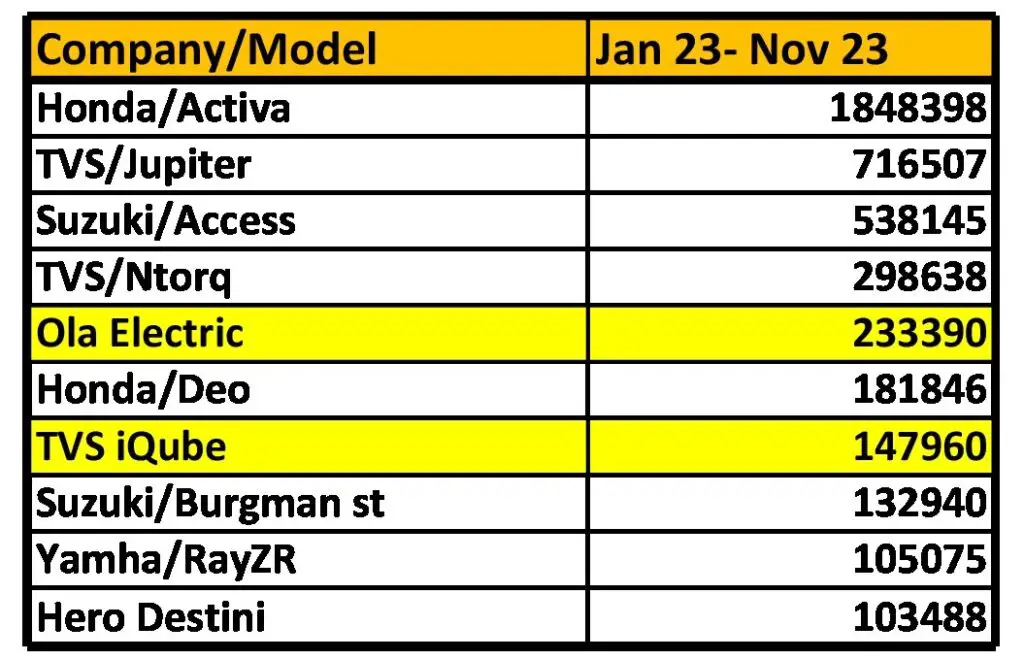November 2023 marked a significant shift in India’s scooter market: electric scooters (EVs) stormed the Top 10 best-selling brands, claiming a substantial share alongside traditional petrol-powered vehicles.

This surge reflects a growing consumer interest in sustainable mobility, with electric sales reaching 93,000 out of 509,119 total scooters sold.
While this rapid adoption is encouraging, challenges remain. Currently, electric scooter sales are concentrated in urban areas due to limitations in sales networks.
Major manufacturers like TVS, Bajaj, and Hero MotoCorp, as well as innovative startups like Ola and Ather, are yet to fully tap into the vast potential of rural markets with electric scooters stocks.
However, promising developments like Ola Electric’s impressive 5Th ranking and TVS iQube’s steady growth at 7Th suggest that EVs are gaining momentum ini top scooter rank.


Advancements in battery technology and price reductions are expected to further boost accessibility, making electric scooters a more attractive option for a wider range of consumers.
Furthermore, the long-term cost benefits of electric scooters cannot be ignored. Compared to their petrol counterparts,
EVs offer significantly lower operating costs, making them a financially sensible choice in the long run. Moreover, expanding sales networks into rural areas could significantly increase total electric scooter penetration, potentially reaching 30% by 2030.
This blog post will delve deeper into the strengths and weaknesses of both ICE and electric scooters, considering various factors like technology, infrastructure, and consumer preferences.
We will explore the challenges and opportunities that lie ahead as India’s scooter market undergoes this transformative shift towards a greener future.
Drivers of the EV Surge
Expanding FAME-II subsidies
Expanding FAME-II subsidies and implementing EV-friendly policies offer a promising path towards rapid EV growth in India.
However, it’s essential to consider the challenges and ensure a balanced approach that fosters long-term market sustainability, equitable access, and environmental responsibility.
By addressing these concerns and taking a holistic approach, India can successfully leverage EVs for cleaner air, economic growth, and technological leadership.
Shifting consumer preferences
Rising fuel prices, environmental concerns, and technological advancements are making EVs more attractive.
The Indian electric vehicle market is experiencing a fascinating shift, with electric scooters leading the charge. This surge in popularity can be attributed to a confluence of factors:
Environmental Concerns
Air pollution is a major concern in India, and electric scooters offer a cleaner alternative to traditional petrol-powered vehicles. This aligns with growing environmental awareness and a desire for sustainable transportation.
Cost-Effectiveness
Electric scooters are significantly cheaper to operate than petrol scooters. Lower running costs due to reduced fuel and maintenance expenses are a major draw for consumers, especially in the current economic climate.
Convenience and Ease of Use
Electric scooters are convenient for navigating city traffic, offering easy parking and maneuverability. Their simple charging process adds to the user-friendly experience.

Technological Advancements
Battery technology advancements have addressed concerns about range anxiety, with newer models offering longer distances on a single charge. This has further boosted consumer confidence in electric scooters.
Evolving Lifestyle
The rise of a millennial and Gen Z population with a focus on convenience, sustainability, and tech-savvy choices has contributed to the popularity of electric scooters. These consumers are more open to embracing new technologies and value eco-friendly solutions.
Innovative features and aesthetics
Modern design, advanced smart features, and focus on connectivity are enhancing the appeal of electric scooters.
The Rural Challenge and Potential Solutions
Developing micro-charging infrastructure
Establishing localized charging networks in rural areas is crucial for addressing range anxiety.

Micro-charging refers to providing smaller, readily available charging solutions compared to conventional stations. This can include:
- Battery swapping stations: Quick exchange of pre-charged batteries for depleted ones.
- Slow charging points: Plugged chargers offering lower power (2-4 kW) for convenient top-ups on the go.
- Fast charging solutions: Fast charging station will defiantly help riders in battery drining conditions
Introducing affordable rural-specific models
Manufacturers can cater to rural needs with budget-friendly electric scooters offering adequate range and practicality.
Mopeds, Low speed and Last mile delivery model will increase the usage in rural areas.
Promoting awareness and education
Building trust and knowledge about EVs through targeted campaigns in rural communities can drive adoption.
Consider initiatives like educational campaigns by e-scooter brands, student discounts, and eco-friendly contests to amplify the impact!
The Future of Scooters: A Balanced Ecosystem
Coexistence of ICE and EVs: Both technologies have their advantages and will likely coexist for the foreseeable future, catering to diverse needs.
Focus on innovation and sustainability
Continuous advancements in battery technology, charging infrastructure, and affordability will be key to long-term success.
Prioritizing safety and regulations
Robust safety standards and regulations are essential to ensure the smooth and responsible evolution of the electric scooter market.
At Last
The top ten scooter list today may be dominated by familiar names, but tomorrow’s picture could be drastically different. As electric scooters gain traction, it’s crucial for both consumers and industry stakeholders to stay informed, adapt, and embrace the shift.
By choosing electric power and supporting its development, we can pave the way for a cleaner, greener, and more sustainable future for Indian transportation.

